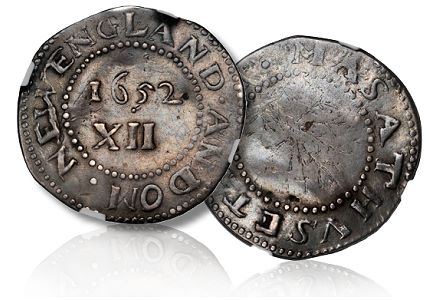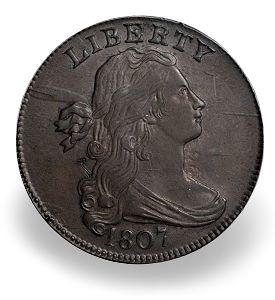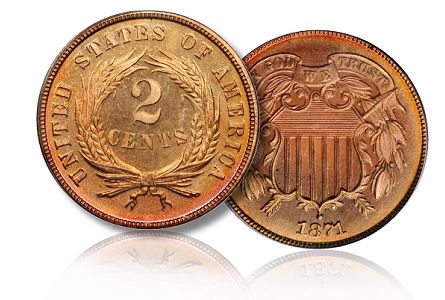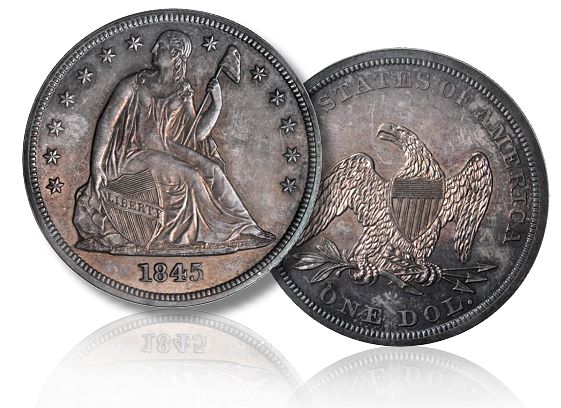News and Analysis of scarce coins, markets, and the collecting community #57
A Weekly Column by Greg Reynolds
In my columns of April 6 and of April 13, I wrote about the first auction by the recently formed Spectrum-Stack’s-Bowers-ANR entity. In my column on The Ten Leading Topics of 2010, I discussed the merger that brought this entity about.
Now, I am writing about their second auction. It is in progress at the Baltimore Convention Center.
A variety of items were auctioned yesterday, June 14, and this Stack’s-Bowers auction will end on Saturday, June 18th, when the Ponterio subsidiary will finish its third session of world coins. The topic here is copper and silver U.S. coins, along with a few pre-Federal items.
The most distinctive component of this auction event is “The Jarapendo Collection” of U.S. Patterns, which will be sold early in the evening of Friday, June 17. Next week, I will write about these patterns and about gold coins in this auction.
Other than that of “Jarapendo,” there does not seem to be any very newsworthy collections being offered. This auction consists of, rather, literally thousands of rare or scarce coins from dozens or hundreds of consignors
I discuss some coins. It should be emphasized, though, that it is NOT my intention for my selections to be a fair sample, statistical or otherwise, of the thousands of coins that Stack’s-Bowers is auctioning this week. Furthermore, it is not practical to even attempt to summarize the offerings. I discuss instead coins that are interesting, particularly likable, especially valuable, or just curious, with a bias towards those coins that I have personally viewed. As always, I include information and opinions that are not found in the catalogue of the auction being covered.
I. Early Material
Although the emphasis herein is upon coins that have yet to be sold, there are some already offered items that I wish to mention. Pre-Federal material, half cents, large cents, small cents, and medals, were sold during Tuesday evening.
 An Oak Tree Shilling is a scarce type of Massachusetts silver. Oak Tree Shillings were minted from 1660 to 1667, according to Walter Breen.
An Oak Tree Shilling is a scarce type of Massachusetts silver. Oak Tree Shillings were minted from 1660 to 1667, according to Walter Breen.
Pine Tree Shillings, also minted in the 1600s, are much less scarce and are accessible to collectors who would like a representative of early Massachusetts coinage. A shilling was a standard British denomination. Massachusetts and the other original States were British colonies before the Declaration of Independence on July 4, 1776.
The Oak Tree Shilling in this auction is of the famous and curious ‘Ghost Tree’ variety. This variety is also known as the “Delicate Tree.” The tree device itself is in extremely low relief.
This Oak Tree Shilling was formerly in the “2nd Collection” of John Roper, which Stack’s (New York) auctioned in 1983. Roper was a famous collector of colonial coins. This shilling is now graded ‘Extremely Fine-40’ by the NGC. When it was last auctioned by Stack’s in January 2007, it was graded “Very Fine-30” by someone at Stack’s. It then realized $9775.
More than a century after Massachusetts silver coins were first struck, the Continental Congress of the newly independent United States began to plan for U.S. coinage. In 1776, patterns of dollar size coins were struck. In this auction, there are three such Continental Currency Dollar patterns.
All three of these were struck in pewter, as were most Continental Currency Dollar patterns. The first was struck with an obverse (front) die that is different from the die that was used to strike the other two. Usually, a collector, of colonials or patterns, will seek to obtain just one Continental Currency Dollar and not bother with the die varieties.
The first of these three is PCGS graded MS-63 and has a sticker of approval from the CAC. I was very impressed with this piece. Breen said that these tend to be “dull” (1988, p. 111, #1092). The surfaces are alive and this pattern grabbed me. It is an unusually exciting Continental Dollar pattern.
The next Continental Dollar pattern, lot #231, is NGC graded “MS-63” and does not have nearly the eye appeal of the first one. The first one is more desirable in other ways as well. The third is PCGS graded “AU-58.”
Despite the production of patterns, plans for Federal U.S. coinage were not implemented until the 1790s. In the interim, coins were issued in some States. In this auction, there is a sizable run of New Jersey coppers of 1787 and 1788. Many die varieties are represented, and these are mostly of interest to specialists in this series.
The offering of half cents in this auction will probably be forgotten. A 1793 half cent is always important as it is a scarce one-year type coin and the first year of Federal U.S. half cents. A different design was adopted in 1794. The lone 1793 half cent in this auction is PCGS graded Very Fine-20.
The offering of large cents contains a wonderful assortment of pre-1804 coins for collectors ‘on a budget.’ Really nice early large cents can be extremely expensive. In contrast, very early large cents that have problems, especially those that are ungradable, are often priced at levels that are a small fraction of high grade pieces of the same respective varieties. It is hard to explain the fun of acquiring a coin that circulated in the U.S. in the 1790s.
 The star of the large cent offering is an 1807 of the variety that appears as though ‘a comet’ is flying behind the head of Miss Liberty. Production imperfections, abrasions and/or tooling in the obverse (front) die coincidentally resulted in the die imparting a shape on the coins struck that looks like an artist’s rendering of a ‘comet.’ It is unlikely that there was any intention to add an artistic shape to the die. There were probably imperfections due to faulty manufacturing of the die and U.S. Mint personnel may have attempted to ‘improve’ this die.
The star of the large cent offering is an 1807 of the variety that appears as though ‘a comet’ is flying behind the head of Miss Liberty. Production imperfections, abrasions and/or tooling in the obverse (front) die coincidentally resulted in the die imparting a shape on the coins struck that looks like an artist’s rendering of a ‘comet.’ It is unlikely that there was any intention to add an artistic shape to the die. There were probably imperfections due to faulty manufacturing of the die and U.S. Mint personnel may have attempted to ‘improve’ this die.
There probably exist fifteen hundred to seventeen hundred Comet large cents in all levels of condition, including the ungradable. The Comet variety is, though, extremely rare in grades above MS-61. This 1807 Comet large cent is PCGS graded “MS-63” and has really choice fields. There are hardly any contact marks and this coin was well struck from a choice, problem-free planchet (prepared blank.) Plus, this 1807 large cent has a good deal of eye appeal.
The guide value at Numismedia.com for an MS-63 grade 1807 Comet is above $22,000. The reserve for this coin is $33,350, including the buyer’s fee.
Though the PCGS has graded at least 15 ‘mint state’ 1807 Comet large cents, experts at the PCGS estimate that there exist just seven that grade “60 or better.” Undoubtedly, some have been re-submitted more than once.
Large cents are much scarcer than Lincoln Cents. In my recent report on the Heritage June 2011 Long Beach auction, I noted that Heritage sold 20 1909-S VDB cents in that event. In the Stack’s-Bowers June 2011 Baltimore auction, there are 18. When I was seven years old, I thought these were extremely rare and of the utmost importance. I would have been rattled if I had then been told that someday so many would be offered in single auctions.
II. 1871 Two Cent Piece
This auction features an 1871 Two Cent Piece that is PCGS certified ‘Proof-67 Red, Cameo.’ For a discussion of color designations, please see my recent piece on Collecting Two Cent Pieces. (As always, clickable links are in blue.)
This is the only Proof 1871 Two Cent Piece that the PCGS has graded 67. None are PCGS certified 67-Brown or 67-Red & Brown and no others are certified as grading 67 with a Cameo or Deep Cameo designation. The PCGS reports that zero Proof 1871 Two Cent Pieces are graded higher than 67. So, this coin is the highest PCGS certified Proof 1871 Two Cent Piece.
 It appears that it may be the same coin that Heritage auctioned for $51,750 in January 2005 in Fort Lauderdale. That coin was PCGS certified ‘Proof-67 Red’ and was in a ‘rattler,’ a first generation PCGS holder, which dates from a time period before explicit ‘Cameo’ designations were a consideration.
It appears that it may be the same coin that Heritage auctioned for $51,750 in January 2005 in Fort Lauderdale. That coin was PCGS certified ‘Proof-67 Red’ and was in a ‘rattler,’ a first generation PCGS holder, which dates from a time period before explicit ‘Cameo’ designations were a consideration.
The term ‘Cameo’ refers to the contrast between white frosted devices (raised design elements) and mirrored fields. Personally, I contend that a Proof coin without a Cameo designation may be superior to one that is designated ‘Cameo’ or ‘Deep Cameo.’ It is a reality in coin markets, however, that a Proof with a Cameo designation tends to be worth more than a Proof of the same type, date and grade that does not have a Cameo designation. Further, a ‘Deep Cameo’ or ‘Ultra Cameo’ designation is usually worth even more than a ‘Cameo’ designation. It is very unusual, though, for a Two Cent Piece to be designated a ‘Deep Cameo’ Proof. It is not difficult to find Proof Morgan silver dollars, of some dates, that are so designated.
By 4:30 PM Eastern Time on Monday, pre-event bidding for this coin had already surpassed $70,000. It has not yet met its reserve of $74,750, including the standard buyer’s commission.
The color of red copper is difficult to capture in images and the pictures on the auction firm’s website do not fairly represent this coin. I have seen it and it is more than very attractive. Further, its full mirrors are cool. As to whether it is the finest known Proof 1871 Two Cent Piece, I am not sure.
The overall offering of Two Cent Pieces in this auction is significant. The 1864 ‘Small Motto’ is the key to the series. One in this auction is NGC certified ‘MS-65 Red & Brown.’ I have not seen it. An 1868, formerly in the Simpson collection, is PCGS certified ‘Proof-66 Red & Brown’ and has a sticker of approval from the CAC.
The 1872 is the scarcest business strike issue in the series. One in this auction is PCGS graded Fine-15.
III. Half Dimes
The run of half dimes in this auction has depth. Half dimes are 90% silver and are smaller than dimes. In 1792, the denomination was spelled ‘Half Disme,’ an archaic term that I do not find to be significant. It makes sense to refer to each as a 1792 half dime. While 1792 half dimes were termed patterns during most of the history of coin collecting in the U.S., these have recently been regarded as regular issues by many experts. The one in this auction is NGC graded “AU-58.” It has appealing natural toning.
 There is no doubt that the half dimes of 1794 are regular issues. One in this auction, from the “Jarapendo” collection, has been ‘off the market’ for decades. It is thus very ‘fresh.’ In my last review of a Stack’s auction, I spelled out the reasons why some coins tend to realize ‘strong’ prices at auction, and I point out that ‘fresh’ coins realize higher prices, on average, not always. (Click here to read.)
There is no doubt that the half dimes of 1794 are regular issues. One in this auction, from the “Jarapendo” collection, has been ‘off the market’ for decades. It is thus very ‘fresh.’ In my last review of a Stack’s auction, I spelled out the reasons why some coins tend to realize ‘strong’ prices at auction, and I point out that ‘fresh’ coins realize higher prices, on average, not always. (Click here to read.)
The Jarapendo 1794 is PCGS graded “AU-58.” Not including the 1792, there are nine pre-1800 half dimes in this auction, all of which have at least the ‘details’ of an Extremely Fine-40 or higher grade. There are five 1797 half dimes, one of which is NGC graded “MS-65.” I have not seen these.
The group of Capped Bust Half Dimes is not fantastic. There seem to be, though, some special Liberty Seated Half Dimes in this auction. Regrettably, I have never seen the 1844 that is NGC certified ‘MS-65 prooflike.’ The cataloguer, Jeff Ambio, suggests that it may be a Proof.
I would also like to see the 1845 half dime in this auction. It was PCGS graded MS-67 long ago, and, more recently, received a sticker of approval from the CAC. The images on the Stacks-Bowers website are certainly impressive. I am also drawn to the listing of an 1854 half dime that is PCGS certified Proof-65 and has a CAC sticker.
IV. Dimes, Quarters & Halves
In this auction, there are a large number of dimes, of all types, that are highly certified. Some are much more appealing than others. There are quite a few very desirable Liberty Seated Dimes and a few Barbers. Indeed, I would suggest that collectors of choice to gem Liberty Seated Dimes or gem Barbers pay at least a little attention to this offering. While every single coin is not great, some are worth pursuing.
I saw the 1821 dime and I am not comfortable with it. The 1825 dime in this auction is, indisputably, a Proof. I am always attracted to Proofs from the 1820s. At a glance, the 1827 dime that is NGC graded MS-63 and the 1829 that is PCGS graded MS-64 seem fairly graded, naturally toned, and nice overall.
 An important Liberty Seated Dime in this sale is the 1864-S that was previously in the Simpson collection. It is PCGS graded “MS-64+,” is in a PCGS Secure Holder, and has a CAC sticker of approval. This same coin was auctioned by Heritage in Sept. 2010, along with the rest of Simpson’s business strike Liberty Seated Dimes, for $6900. This is a very rare date. The Simpson 1864-S and the NGC graded “MS-65” 1864-S in this auction are especially noteworthy coins.
An important Liberty Seated Dime in this sale is the 1864-S that was previously in the Simpson collection. It is PCGS graded “MS-64+,” is in a PCGS Secure Holder, and has a CAC sticker of approval. This same coin was auctioned by Heritage in Sept. 2010, along with the rest of Simpson’s business strike Liberty Seated Dimes, for $6900. This is a very rare date. The Simpson 1864-S and the NGC graded “MS-65” 1864-S in this auction are especially noteworthy coins.
I wish I had seen the 1899-S and 1900-O Barber Dimes. These are both condition rarities and dates that are relatively scarce in all grades. These two dimes are both PCGS graded “MS-66” and each has a CAC sticker.
There are 34 Twenty Cent Pieces in this auction. Business strikes of this denomination were struck for only two years, and Proofs for only four years, 1875 to 1878. The lone 1877 and the lone 1878 are both from the “Jarapendo Collection” and are thus very fresh.
I am not prepared to discuss the quarters and halves at length. I do not recognize them and I was unable to examine them this month. My impression is that this is not a landmark auction for quarters or halves.
Someone who is assembling a set of Barber Quarters ‘on a tight budget’ may wish to know that a PCGS graded “AG-03” 1901-S will be offered, which, presumably, will be much less expensive than most other 1901-S quarters. This auction also includes two PCGS certified, circulated 1913-S quarters, a key date that some collectors find to be very costly. The first 1913-S is graded ‘Very Good-10’ and the second is graded ‘Good-06.’ Key date Barber Quarters in all grades, 1896-S, 1901-S and 1913-S, should be certified, as fakes are common.
I wish that I had seen the Kaufman-“Thomas” 1809 half. It is NGC graded “MS-66*.” I did see the 1836 Reeded Edge Half Dollar that is NGC graded “MS-64,” and I am not thrilled about it.
A 1916 Walking Liberty Half Dollar is NGC graded MS-68 and will attract attention. A 1921 Walker, PCGS graded MS-65, was formerly in the Sounder collection. The ‘Sounder’ PCGS Registry sets of Walking Liberty Half Dollars were “retired” in August 2006. Each collector who is interested in coins in an auction should hire an expert to examine lots on his (or her) behalf.
V. Eliasberg 1795 Dollar
A 1795 Flowing Hair silver dollar in this auction was previously in the greatest coin collection of all time, that of Louis Eliasberg. It is being offered as lot #4001 in this sale. This coin is currently NGC graded MS-63. Its history is not detailed in the catalogue.
When Heritage auctioned this exact same coin in December 2005, a history of the coin was stated, (I add terms in brackets.) “Ex: The George Earle Collection (Henry Chapman [auction firm], June 1912), lot 2682; John H. Clapp Estate to Louis Eliasberg, Sr. [via Stack’s] in 1942; The Eliasberg Collection (Bowers and Merena [New Hampshire], April 1997), lot 2170; The [Phillip] Flannagan Collection (Bowers and Merena, November 2001), lot 4208.” The Heritage cataloguer, however, omitted the fact that this 1795 silver dollar had been auctioned by ANR in New York on June 30, 2005.
ANR auctioned the famous Cardinal Collection of bust dollars. This set was assembled by Martin Logies, who is the founder and curator of the Cardinal Educational Foundation. The Cardinal Foundation currently owns the finest known 1794 dollar and previously owned two other 1794 silver dollars.
Please see my column on the recent sale of the Connecticut-Hesselgesser 1794 dollar and my column of August 11.
This Earle-Eliasberg-Flannagan-Cardinal 1795 dollar was previously PCGS graded MS-62 and is now NGC graded MS-63. It realized $71,875 in June 2005 and $77,625 in Dec. 2005. Now that it is graded “MS-63,” it may realize much more. It is an attractive coin.
VI. Proof Liberty Seated Dollars
There is a noteworthy run of Proof Liberty Seated Dollars in this auction. I saw a few of them.
 The star of the group is an 1845. It is PCGS certified ‘Proof-65’ and is in a ‘Secure Holder.’ When Heritage auctioned this same coin in 2009, it was NGC certified Proof-65. A Heritage cataloguer then offered an extensive pedigree, which is consistent with my notes, “Heritage (6/1987), lot 4372; Superior (1/1989), lot 4696; David Akers (Auction ’89, 7/1989), lot 1153; Kenneth C. Long Estate (Bowers and Merena, 5/1995), lot 1215; The La Jolla Collection (Superior, 1/2004), lot 2564; Jack Lee Collection; Heritage (1/2006), lot 11605.” In April 2009, it was as part of the “Joseph Thomas” collection.
The star of the group is an 1845. It is PCGS certified ‘Proof-65’ and is in a ‘Secure Holder.’ When Heritage auctioned this same coin in 2009, it was NGC certified Proof-65. A Heritage cataloguer then offered an extensive pedigree, which is consistent with my notes, “Heritage (6/1987), lot 4372; Superior (1/1989), lot 4696; David Akers (Auction ’89, 7/1989), lot 1153; Kenneth C. Long Estate (Bowers and Merena, 5/1995), lot 1215; The La Jolla Collection (Superior, 1/2004), lot 2564; Jack Lee Collection; Heritage (1/2006), lot 11605.” In April 2009, it was as part of the “Joseph Thomas” collection.
I strongly believe that it is a very convincing Proof and that its grade falls in the middle to high end of the 65 range. Its toning is natural, stable and attractive. It has probably never been cleaned and, most likely, never been dipped either. It would be a travesty if someone dipped it in the future. While this coin is not very brilliant, shades of blue, tan, russet, green and gray blend nicely and are pleasing. When this coin is tilted under a light, its mirrors are strong and full.
In this same auction, there is an 1854 that is NGC certified “Proof-64 Ultra Cameo.” While I like the coin, I am not sure about this certification.
An 1860 dollar is PCGS certified ‘Proof-64 Cameo’ and has a CAC sticker of approval. Though it has been lightly dipped in the past, I grade this coin ’64+’ and I am accepting of the Cameo designation.
I quickly glanced at the 1862 dollar that is NGC certified “Proof-66+.” I am unsure about it.
I like the 1863. It is PCGS certified Proof-66. The blue-green central design elements contrast well with brown-russet fields that include blends of green and gray tones. This 1863 is a very attractive, Proof-66 Liberty Seated Dollar.
I did not see the 1867, 1869, 1871 and 1873 Liberty Seated Dollars that are certified as Proofs. The 1869 is from the “Jarapendo Collection” and was thus ‘off the market’ for decades. Next week, I will write about the patterns in the “Jarapendo Collection.”
Almost every major coin auction has a large selection of Morgan Dollars, which are not rare coins. In this auction, the offering of Morgans is larger and better than most. There are some impressive coins and there are some that I would not recommend. Unfortunately, it is just not practical to discuss them here. As I indicated at the onset, I cannot report on a large number of the thousands of coins in this auction. I look forward to writing about at least several of the U.S. gold coins next week.
©2011 Greg Reynolds
Walking Liberty Half Dollars Currently Available on eBay
[wpebayads]





That Eliasberg 1795 Dollar sure is an interesting piece. Seems like the show on whole is pretty strong this year.